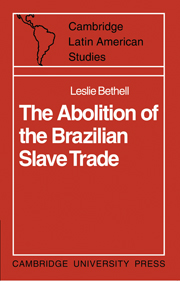Book contents
- Frontmatter
- Contents
- Preface
- Maps
- Abbreviations
- 1 First steps towards abolition, 1807–1822
- 2 Independence and abolition, 1822–1826
- 3 Brazil and the slave trade, 1827–1839
- 4 Treaty negotiations, 1830–1839
- 5 The British navy and the mixed commissions, 1830–1839
- 6 The extension of Britain's powers, 1839
- 7 Britain and the slave trade, 1839–1845
- 8 Slave trade, slavery and sugar duties, 1839–1844
- 9 Lord Aberdeen's Act of 1845
- 10 The aftermath of the Aberdeen Act
- 11 Changing attitudes and plans of action, 1845–1850
- 12 Crisis and final abolition, 1850–1851
- 13 The aftermath of abolition
- Appendix: Estimates of slaves imported into Brazil, 1831–1855
- Bibliography
- Index
1 - First steps towards abolition, 1807–1822
Published online by Cambridge University Press: 04 August 2010
- Frontmatter
- Contents
- Preface
- Maps
- Abbreviations
- 1 First steps towards abolition, 1807–1822
- 2 Independence and abolition, 1822–1826
- 3 Brazil and the slave trade, 1827–1839
- 4 Treaty negotiations, 1830–1839
- 5 The British navy and the mixed commissions, 1830–1839
- 6 The extension of Britain's powers, 1839
- 7 Britain and the slave trade, 1839–1845
- 8 Slave trade, slavery and sugar duties, 1839–1844
- 9 Lord Aberdeen's Act of 1845
- 10 The aftermath of the Aberdeen Act
- 11 Changing attitudes and plans of action, 1845–1850
- 12 Crisis and final abolition, 1850–1851
- 13 The aftermath of abolition
- Appendix: Estimates of slaves imported into Brazil, 1831–1855
- Bibliography
- Index
Summary
At the beginning of the nineteenth century when Britain launched her crusade against the transatlantic slave trade, there was no nation more deeply involved in the exportation, transportation and importation of African slaves than Portugal. Although the African territory effectively occupied or controlled by the Portuguese (who had first discovered and explored the coastline of Africa three and a half centuries before) scarcely extended beyond a few scattered towns, settlements and fortified trading posts along the coast and along the banks of the great rivers, thousands of slaves were annually exported to the New World from those parts of the African continent claimed by the Portuguese Crown as part of its vast overseas dominions. Bissão and Cacheu in what is now Portuguese Guinea, which were governed from the Cape Verde Islands, had already been virtually ‘slaved out’ and the Portuguese had long since lost to the English, the French, the Dutch and the Danes their monopoly of trade on the Costa da Mina (the coastline north of, and parallel with, the equator, stretching from Cape Palmas to the Cameroons and embracing the Ivory, Gold and Slave Coasts, sometimes collectively known as the Guinea Coast). But they retained the islands of São Tomé and Prícipe in the Gulf of Guinea, through which a great number of slaves were exported, and the fortified post of São João Baptista de Ajudá at Whydah in Dahomey, perhaps the most important slave port north of the equator.
- Type
- Chapter
- Information
- The Abolition of the Brazilian Slave TradeBritain, Brazil and the Slave Trade Question, pp. 1 - 26Publisher: Cambridge University PressPrint publication year: 1970

